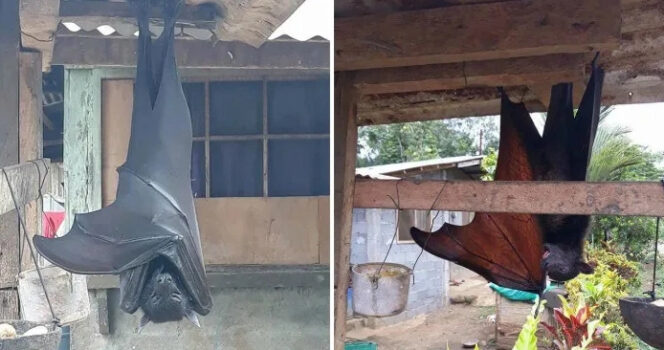# Unraveling the Mysteries of These Human-Sized Flying Wonders

With a wingspan nearly as wide as Tom Cruise is tall, the gigantic Philippine flying fox looks terrifying as it soars through the air with its outstretched arms. Additionally, its thin hairy body accentuates the enormity of its wings. And when it sleeps, it resembles a vampire, draped in its rubbery black cloak.
## Bats “human-sized”
Despite its impressive size, the fruit-eating megabat – part of a native Filipino species – is harmless. It makes no attempts to attack humans. Unfortunately, they are illegally hunted, putting them on the list of endangered species.
[Viral images](https://twitter.com/AlexJoestar622/status/1275653432897126401/photo/2) of these innocent, threatened creatures sparked both interest and fear. As expected, people were shocked by their size and predatory appearance.
When the initial images went viral, they were described as bats “human-sized.” This turned out to be an unfortunate description that caused both confusion and fear.
The gigantic Philippine flying fox is one of the largest bat species in the world. This bat species has a wingspan of about 1.80 m. This can easily carry its small body, between 18 and 29 cm long and weighing about 1.5 kg.
## Herbivore
The fig-loving bat, with its head covered in a hairy golden crown, is a nocturnal herbivore. It searches for food at night, primarily roots, fruits, and vegetables.
While other species of flying foxes exist in Asia, Africa, and Australia, the Philippine flying fox (Acerodon jubatus) is found exclusively in the jungles of the Philippines, where it often lives in colonies of up to 10,000 members.
During the day, it slumbers, hanging from its clawed toes high in the treetops with a group of friends or its smaller cousins from the Acerodon family.
## Their Contribution to the Ecosystem
Unlike many other bats, the giant Philippine flying fox does not rely on echolocation. It prefers to use its vision and smell to navigate through the airspace.
Tirelessly working to combat deforestation, the flying fox plays a crucial role in the multiple-forest ecosystem. By redistributing fig seeds after feeding, it contributes to reforestation in the Philippines.
Unfortunately, the more the bats work, the more humans destroy.
## Endangered Species
According to [Bat Conservation International](https://www.batcon.org/article/goldencrowned-flying-fox/) (BCI), “more than 90 percent of old growth forests in the Philippines have been destroyed. This has resulted in the species completely disappearing from multiple islands.”
The destruction of its natural habitat and hunting, for sale, sport, and personal consumption, are leading to a rapid reduction in their population. It has decreased by 50 percent between 1986 and 2016. Since then, the species has been classified as an endangered species by The International Union for Conservation of Nature (IUCN).
Although the bats are protected by the 2001 Philippine Wildlife Conservation and Protection Act, the law is not being enforced.
While most roosting sites of these animals are in protected areas, they are still being killed in large numbers. In an extremely cruel and inhumane way, hunters shoot the sleeping animals as they hang from their roost, with some of them getting injured, many with their toes still gripping the branch so they cannot fall while being killed.
## Not Skittish Towards Humans
And although humans pose a massive threat to the bat population, the Philippine flying foxes are not skittish. They can easily be found in forests near villages or towns. Sometimes, you will find them perched alongside roads and hanging around in populated areas where they feel comfortable. Being able to distinguish between safe and dangerous areas, they move to areas that are inaccessible to people, such as slopes over 300 meters above sea level.
These bats are also extremely intelligent beings, comparable to dogs. Studies show they learn quickly and have a significant memory.
From a [study](https://www.researchgate.net/publication/216483583_Flick_B_Spencer_H_van_der_Zwan_R_2011_Are_hand-raised_flying_foxes_Pteropus_conspicillatus_better_learners_than_wild-raised_ones_in_an_operant_conditioning_situation) on active conditioning, it was found that hand-raised flying foxes were successfully trained to operate levers in exchange for a juice. More importantly, when the bats returned to the familiar experimental chamber three and a half years later, they immediately operated the levers, knowing they would be rewarded.
## Creepy – or Cute – Features?
Bats have unique physical features that can be disturbing or frightening to some people. Their leathery wings, sharp teeth, and large eyes can contribute to an anxious or uncomfortable feeling.
They have a bad reputation as bloodthirsty creatures, but it’s important to note that only 3 out of the 1,300 bat species drink blood. If you can get past the initial shock of their creepiness, the Philippine flying foxes are actually quite adorable!
It’s really sad to know that these innocent and intelligent animals are being killed and losing their habitat due to deforestation. If you agree, please share this story and help raise awareness for this endangered, harmless species!



